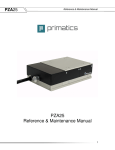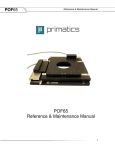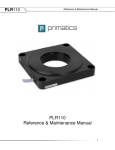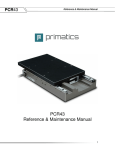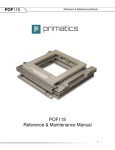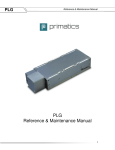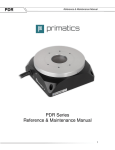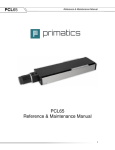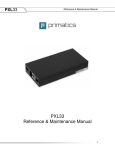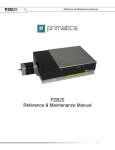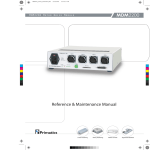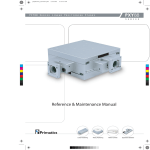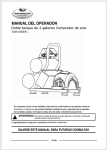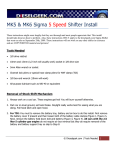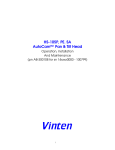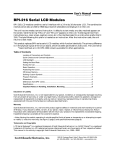Download PFR225 Reference & Maintenance Manual
Transcript
PFR225 Reference & Maintenance Manual PFR225 Reference & Maintenance Manual 1 PFR225 Reference & Maintenance Manual 32114 Mallard Ave. PO Box 409 Tangent, OR 97389-0409 U.S.A. Phone: Fax: Toll Free: Web: E-mail: [541] 791-9678 [541] 791-9410 [888] 754-3111 www.primatics.com [email protected] PFR225 Manual Revision Information Publication Date Dec 2000 May 2005 Jan 2015 Notes Updated look & formatting New Logo Notice: The descriptions, drawings, and specifications contained herein are subject to change. Primatics is not responsible for errors or omissions herein or for incidental damages in connection with the furnishing or use of this information. This document shall not be reproduced, photocopied, or duplicated, in whole or in part, without prior written approval of Primatics Corporation. For Specifications, Dimensioned Drawings and additional information, refer to the PFR Family Datasheet available from our website at www.primatics.com. ©Copyright 2007-2015 by Primatics, Inc; All Rights Reserved. Primatics, the Primatics logo, PrimaFlex, PrimaSeal & SimpleMatch are trademarks of Primatics, Inc. 2 PFR225 Reference & Maintenance Manual PFR225 Manual Revision Information ............................................................... 2 1) Overview .......................................................................................................... 4 2) Introduction – About the PFR Series ............................................................ 5 3) Model Configuration ....................................................................................... 6 4) Personal Safety ................................................................................. 7 5) Stage & Manual Conventions ........................................................................ 8 5.1) Direction of Motion ............................................................................................................ 8 5.2) Units of Measure ............................................................................................................... 8 6) Installation Preparations ................................................................................ 9 6.1) Heat and Humidity............................................................................................................. 9 6.2) Environment .................................................................................................................... 10 6.3) Electrical Noise ............................................................................................................... 10 7) Installation Procedures ................................................................................ 11 7.1) Tools you will need.......................................................................................................... 11 7.2) Unpacking ....................................................................................................................... 11 7.3) Mounting surface preparation ......................................................................................... 12 7.4) Electrical Connection ...................................................................................................... 12 7.4.1) Color Codes for Pigtailed Cable ................................................................................... 14 7.4.2) Hall Effect Commutation Sequence ............................................................................. 15 7.5) Home and Limit Sensors ................................................................................................. 15 7.5.1) Home Options: ............................................................................................................. 16 7.6) Limit and Home Switch Adjustment ................................................................................ 17 7.7) Recommended System Test ........................................................................................... 18 8) Preventive Maintenance ............................................................................... 19 8.1) Belt Tension .................................................................................................................... 19 8.2) Belt Tension Adjustment ................................................................................................. 20 8.3) Belt Lubrication ............................................................................................................... 21 9) Troubleshooting & Service .......................................................................... 22 9.1) Troubleshooting Help ...................................................................................................... 22 9.2) Service ............................................................................................................................ 22 3 PFR225 Reference & Maintenance Manual 1) Overview This user guide is designed to help you install and maintain your PFR Series rotary positioning stage application. Follow these steps to ensure correct stage installation and maximum stage life: Step 1 Review this entire user manual. Become familiar with all installation procedures prior to integrating your system. Step 2 Review the safety summary to develop an understanding of standard safety practices when installing and operating automated equipment. Step 3 Familiarize yourself with the conventions summary. Step 4 Review installation procedures. For best results, follow these procedures carefully. Step 5 Once you successfully complete all the installation procedures, you will be ready to install and operate your stage. Step 6 Review preventive maintenance section for proper lubrication schedule. 4 PFR225 Reference & Maintenance Manual 2) Introduction – About the PFR Series Each Primatics PFR positioning stage is designed for precision rotary movement. An innovative drive system creates arc-second repeatability and fast settling times, making the PFR ideal for point to point indexing, assembly and optical applications. Many customers choose the Primatics Motion Drive Chassis (MDC) to power PFR stages. The MDC is a modular system that packages motor drivers, encoder interfaces, power supplies and safety systems into a single chassis. It acts as an intermediary between a Galil Optima, National Instruments 7344 or Delta Tau PMAC II motion control cards and a Primatics positioning stage. Pre-wired high-flex cables are available to allow a convenient connection from the stage to the MDC chassis. The MDC drive chassis rd interfaces 3 party controllers via a removable interconnect module. These interconnect modules conform to each manufacturers interconnect cable, and internally route all the command and I/O signals. Optionally, a Primatics positioning stage can be used with many third party controller and amplifier systems. In this case, a pigtailed cable is available to simplify the connection between the PFR and controls. 5 PFR225 Reference & Maintenance Manual 3) Model Configuration 6 PFR225 Reference & Maintenance Manual 4) Personal Safety Please review before installing your positioning stage Observe common industrial safety practices when installing and operating automated equipment. o Have power connections made by qualified personnel. o Keep fingers and other items out of any opening in the stage while it is in operation since injury or damage may result. o Provide a safe access route and adequate room for servicing. o Perform the recommended periodic maintenance described in this document. o Verify that the work envelope is free of obstructions before the positioning stage is powered. o Insure that you have the feedback wired properly to the controller before applying power to the positioning stage. Improper feedback connections can cause a motor run-away condition that has the potential to damage the stage and injure an operator. o Only trained operators of the positioning stage should be allowed near the work environment. o If so equipped, identify emergency stop circuits and actuators in workcell. o Note the places in the workcell where pinch points occur, and provide adequate safety clearance or safety curtain. o Never operate the motor in a location that could be splashed by water, exposed to corrosive or flammable gases or is near combustible substances since this may cause an electric shock, fire or malfunction. o Never touch the motor, driver, or peripheral devices when the power is on or immediately after the power is turned off. The high temperature of these parts may cause burns. 7 PFR225 Reference & Maintenance Manual 5) Stage & Manual Conventions 5.1) Direction of Motion The positive direction of motion is defined as a rotation in the counter clockwise direction as one is looking down on the stage platen. The encoder is wired so that the encoder count increases as the stage rotates in the positive direction. Figure 5-1 illustrates this convention. Figure 5-1: Positive direction convention 5.2) Units of Measure Primatics uses the metric system for all specifications and dimensions. All linear dimensions are specified in millimeters. Angular displacement is specified in degrees. Accuracy error and repeatability for the PFR is expressed in arc-seconds (1 degree = 3600 arc-seconds). Load capacity is specified in kilograms and moment capacity is given in Newton-meters. All torque specifications are given in Newton-meters. Thrust specifications are given in Newtons. The following table gives some common conversions into English units: Metric Unit English Unit 1 Kilogram equals 0.0685 slug* 1 micron equals 0.0000394 inch 1 millimeter equals 0.0394 inch 1 Newton-meter equals 8.85 in-lbs 1 Newton equals 0.2248 lbs 2 *1 Kg has a weight of 2.205 lb when g = 9.8 m / s 8 PFR225 Reference & Maintenance Manual 6) Installation Preparations This section outlines installation environments. Unfavorable installation conditions may cause electric shock, fire, or breakdown. Certain breakdown situations or malfunctions in particular may lead to serious injury or other consequences. Assure that the unit is used under the following installation conditions: o o o o o o Indoors, free from being splashed by water No corrosive or inflammable gases present Well ventilated place, minimum level of dust or waste An environmental temperature range between 0-40°C, and humidity between 2080% RH (location with no condensation). Note - These values show the range in which operation can be carried out safely, but not the environmental range in which stage accuracy can be guaranteed. Stage accuracy can be guaranteed at 20°C +/- 1°C. Location should not be affected by electrical noise. Location should be where inspection and cleaning can be performed without difficulty. 6.1) Heat and Humidity All positioning stages are assembled and tested at 20°C. Any stage calibrations are also performed at 20°C. For optimum accuracy the ambient temperature should be maintained at 20°C. Deviations from this nominal temperature may result in degraded accuracy performance. Ballscrew driven stages are also susceptible to thermal expansion effects. The ballscrew nut can create a localized thermal gradient if driven at high speeds. Air flow through the stage can help minimize ballnut heating. 9 PFR225 Reference & Maintenance Manual 6.2) Environment Applications in dusty or dirty environments require the electrical, optical and mechanical components to be protected. The PFR series is intended for clean environments free from small particulates and fluids. The cover protection and high-pressure (60100psi)/low flow air purge system (P1 options) is sufficient for environments generating moderate quantities of 0.25 mm and larger particles. However, for dusty, wet, or harsh environments or applications with continuous exposure to smaller contaminants, additional protection must be designed. If P2 High Flow Air Purge is in use, airflow through a stage must be filtered and dry. The filtration system should reject particles larger than 2 microns. Air pressures between 60100 psi are sufficient for convection cooling. Air should be routed into the stage through the 4mm OD pneumatic hose located next to the power cable. A typical air source can be made suitable with the addition of an inline desiccant dryer and filter/regulator assembly. Humidity should be less than 85% and there should be no condensation in the environment the stage is used in. 6.3) Electrical Noise Electrical noise is the corruption of signals carried over low voltage wires. Encoder signals can be corrupted resulting in spurious encoder counts thus causing the stage to drift. Grounding, shielding, and spatial separation are all countermeasures to reduce the influences of electrical noise on performance. You can minimize the potential for electrical noise by observing the following installation precautions: o o o Physically separate low voltage conductors from those carrying high voltage. Ensure that all components are properly grounded. Ensure that all wiring is properly shielded. 10 PFR225 Reference & Maintenance Manual 7) Installation Procedures 7.1) Tools you will need To install the PFR stage, you will need the hex wrenches listed below. PFR100 PFR225 Cover M2 M2.5 Base Plate M4 ¼” or M6 Rotary Platen M4 M5 & M6 7.2) Unpacking Carefully remove the stage from its shipping crate and inspect it for evidence of shipping damage. Report any damage immediately to your authorized dealer. Improper handling of the stage may degrade its performance. Follow these guidelines when handling and mounting your stage. 1) Do not drop the stage onto its mounting surface. Place the stage gently on the mounting surface. Impact loads can cause high spots on mounting surfaces, misalignment of drive components and warping of the base. 2) Do not drill holes into the stage. If additional holes are necessary, contact your local distributor. 3) Lift the stage by its base structure only. 4) Stage disassembly and alteration, unless specified otherwise, may void warranty. 11 PFR225 Reference & Maintenance Manual 7.3) Mounting surface preparation The characteristics of the surface the positioning stage is mounted to will have a large effect on system performance. An accurate and flat positioning stage will conform to the shape of its mounting surface, therefore a flat mounting surface is required. In the absence of a sufficiently flat surface, a three point mounting scheme can be utilized to rely on the inherent flatness of the stage. This technique can introduce negative dynamic effects in moment load applications because a large portion of the stage base is not in contact with the mounting surface. The flatness and straightness specifications can be affected under large loads. For best results in maintaining stage specifications we suggest the following: 1) Use a laboratory Grade AA granite surface plate 2) Before mounting stage, inspect for burrs or dings on the stage mounting surfaces 3) Clean all mounting surfaces with acetone In the absence of a granite surface plate, we recommend a base plate made of the same material as the base of the stage. A mounting surface constructed out of a material different from the stage base material can introduce warping in the stage in the presence of a thermal gradient. The surface flatness should match the requirements of the application; a good starting point is to have the mounting surface flat to less than 5-8µm. 7.4) Electrical Connection All PFR models are terminated with a 450mm flexible cable with a 28 position circular connector on the end. The pin-out of this connector is shown with Table 7-1. This particular configuration is optimized for use with Primatics MDC drive chassis via an extension cable. Extension cables compatible with this circular connector are available from Primatics. No other connections are necessary for the PFR. A popular option for applications not using the Primatics MDC drive chassis is the pigtailed extension cable. This is similar to the extension cable used to connect a stage to the MDC drive chassis, except the end that connects to the drive is un-terminated for easy connection to a user-supplied motion controller. Section 7.4.1 shows the conductor assignments for this cable. 12 PFR225 Reference & Maintenance Manual Table 7-1: Axis Connector (Motor, encoder, limits, home, temp) FCI circular connector, 28 pins, size 20 shell Pin A B C D E F G H J K L M N P R S T U V W X Y Z a b c d e Function Motor A Motor B Motor C Motor Shield Encoder 5V – power for encoder Encoder A+ output Encoder A- output Encoder B+ output Encoder B- output Encoder Shield 12-24VDC - for limit, home, and temp sensor DCCOM Home Not used Not used Chassis Hall V+ Hall VEncoder Common Encoder Index + Encoder Index Forward Limit Switch Reverse Limit Switch Signal Shield Hall A Hall B Temperature monitor – connect to DC Common for temperature OK Hall C 13 PFR225 Reference & Maintenance Manual 7.4.1) Color Codes for Pigtailed Cable Cable consists of 3 independent shielded “pods”: One for motor signals, one for encoder rd signals & a 3 for sensors and brake. Each of the pods is described below. Cable 1 █ █ □ █ Color Black Red White Shld Function Motor R Motor S Motor T Motor Shield Cable 2 █ □ █ █ █ █ █ █ █ Color Red White Yellow Green Blue Shld Black Orange Brown Function Encoder 5V Encoder A+ output Encoder A- output Encoder B+ output Encoder B- output Encoder Shield Encoder Common Encoder Index + Encoder Index - Cable 3 █ █ □ □/█ □/█ █ █ █ █ █ █ █ █ █ Color Green Blue White Wht/Red Wht/Black Shld Black Brown Violet Gray Red Orange Tan Yellow Function 12VDC DCCOM Home Not used Not used Chassis Hall V+ Hall VForward Limit Switch Reverse Limit Switch Hall A Hall B Temperature Monitor Hall C 14 PFR225 Reference & Maintenance Manual 7.4.2) Hall Effect Commutation Sequence In the event that user amplifier and controls are being implemented, use the following motor commutation timing charts. Figure 7-1: Motor commutation chart Figure 7-2: Timing diagram for the encoder signals 7.5) Home and Limit Sensors Each PFR model includes a Home Sensor used for homing the state. Forward and Reverse Limit Sensors are optional and may or may not be included in a specific model. The internal motors include an over temperature switch. Figure 7-3 shows the equivalent schematic for these sensors and switches. 15 PFR225 Reference & Maintenance Manual Figure 7-3: Equivalent Limit, Home, and Temp circuit schematic 7.5.1) Home Options: The Home switch is ordered in either the Normally Closed (H1) or Normally Open (H2) configuration H1: Switch is closed when carriage is between the negative (reverse) end of travel and the home transition point. It is open from the transition point to forward end of travel. H2: Switch is open when carriage is between the negative (reverse) end of travel and the home transition point. It is closed from the transition point to forward end of travel. 7.5.2) Limit Options: The Limit switches are ordered in either the Normally Closed (L1, L3) or Normally Open (L2, L4) configuration If the PFR is specified with either the L3 or L4 options, the switches are replaced with a permanently Closed (L3) or Open (L4) circuit. This feature offers compatibility with other positioning stages and controls. L1: When the carriage is in the normal operating range of travel, both limit switches are closed. When the carriage encounters a limit the switch opens. The switch will close again when the carriage is moved away from the switch. L2: When the carriage is in the normal operating range of travel, both limit switches are open. When the carriage encounters a limit the switch closes. The switch will open again when the carriage is moved away from the switch. 16 PFR225 Reference & Maintenance Manual 7.6) Limit and Home Switch Adjustment The limit and home switch positions are preset at the factory. The limits are nominally set to yield slightly more travel than specified in the model configuration. The nominal home switch transition point is about 2° to the positive side of the center of travel. Figure 7-4 shows the default signal transition points. Figure 7-4: Limit & Home Switch PCB and Home & Limit Switch Ring Figure 7-5: Limit and Home Sensor Transition Ranges for PFR225 The home and limit signals are each produced by separate reflective sensors mounted to the base next to the platen. A white reflective strip (the home vane) mounted on the platen is viewed by each sensor. A special non-reflective black tape is applied to the home vane. Each switch is closed when viewing the white area and is open when viewing the non-reflective tape. Figure 7-6A shows the tape configuration for the normally closed sensor options (H1, L1 & L3). Figure 7-6B shows the tape configuration for the normally open sensor options (H2, L2 & L4). The point at which each signal transition occurs can be adjusted by adding or removing the non-reflective tape. The home sensor can also be reconfigured to a momentary switch by adding or removing tape. 17 PFR225 Reference & Maintenance Manual Figure 7-6A: Home Vane Configuration H1, L1 & L3 Options (Normally Closed) Figure 7-6B: Home Vane Configuration H2, L2 & L4 Options (Normally Open) 7.7) Recommended System Test Before attaching a load or applying power to your stage, verify the encoder and limit switches are working properly. Move the stage platen by hand in the positive direction (counterclockwise, see Figure 5-1). Runaway conditions caused by miswired encoders can result in stage damage and personal injury. When closing the position loop for the first time, set the torque limit of your controller to a low value, and use conservative tuning gains. Once the control loop is working properly, payloads can be added to the stage platen. 18 PFR225 Reference & Maintenance Manual 8) Preventive Maintenance 8.1) Belt Tension The PFR will operate through a fairly broad range of belt tension. However, too much or too little tension will manifest itself in “notchiness” of rotation, control problems and premature belt wear. When the belt is tensioned correctly, the motion should feel smooth when the platen is rotated by hand. Figure 8-1 illustrates that when the belt is tensioned correctly, a 10 lb side load will deflect the belt 3mm at the motor housing. Figure 8-1: Testing Belt Tension 19 PFR225 Reference & Maintenance Manual 8.2) Belt Tension Adjustment 1) Remove Top Covers 2) Loosen the 4 ea M5 SHCS that secure the motor housing to the base with a M4 Hex Driver. They should be barely loose enough to allow the housing to slide in the slot it is captured in. 3) With an M3 Hex Wrench turn the tensioning screw on the opposite side of the stage – clockwise to tension, counterclockwise to loosen. 4) Retighten the Motor Housing Screws. 5) Reattach Top Covers 20 PFR225 Reference & Maintenance Manual 8.3) Belt Lubrication The drive belt operates most smoothly if it has a light coat of grease on its teeth. This should not be done in harsh environments. Not more often than yearly, apply a small amount of #2 grease to the middle of the toothed side of the belt. The engagement of the belt on the pulley will spread the grease to the edges. 21 PFR225 Reference & Maintenance Manual 9) Troubleshooting & Service 9.1) Troubleshooting Help For further assistance contact the factory: M-F 8AM to 5PM Pacific Time Phone: Fax: Toll Free: Web: E-mail: [541] 791-9678 [541] 791-9410 [888] 754-3111 www.primatics.com [email protected] 9.2) Service Should your device require factory service, contact the factory for a Return Materials Authorization (RMA). When inquiring about an RMA please have the following information available: o Your contact information (name, phone, email, address) o Unit Serial Number (see Figure 9-1) o Symptom of problem o History of troubleshooting steps already taken Figure 9-1: Unit Serial Number Location 22






















